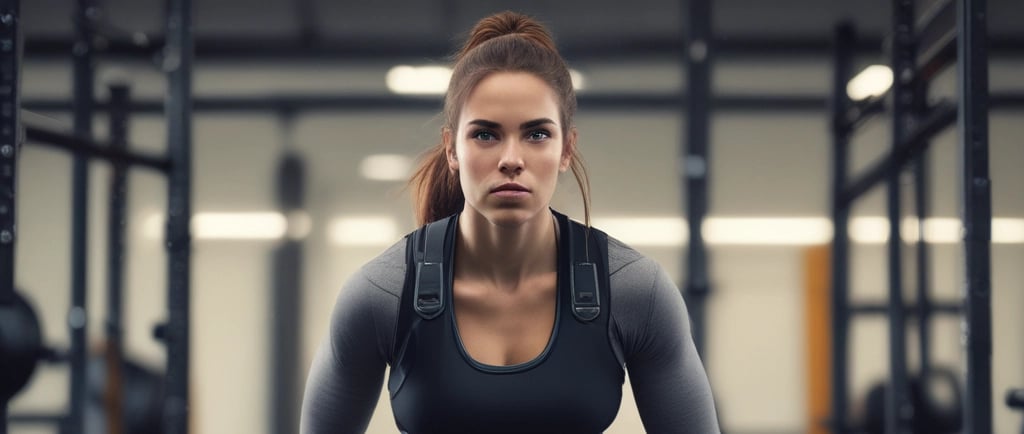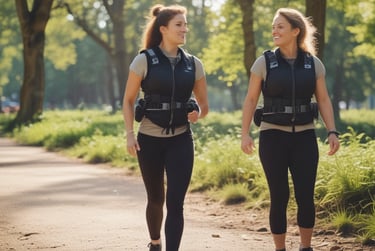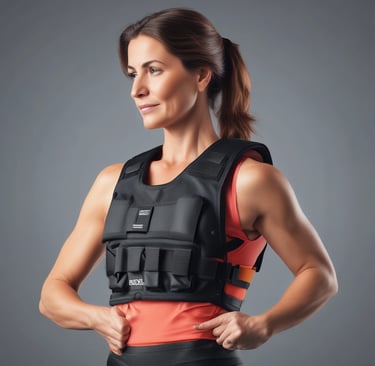Benefits of Weighted Vests for Women
Discover the numerous benefits of women using weighted vests, explore sample workouts tailored for optimal results, and find the best rated weighted vests to enhance your fitness journey.
11/5/20254 min read


Understanding Weighted Vest Workouts
Think of a weighted vest as a sneaky sidekick for your workouts: it quietly adds resistance so every squat, lunge, and burpee feels a bit more heroic. Lately, weighted vests have become a favorite tool — especially for women who want to get more out of bodyweight moves without hauling around a barbell. The vest distributes extra weight across your torso so your whole body works harder, improving strength, stamina, and overall fitness in a simple, adaptable way.
How to use a weighted vest safely (so you can feel fierce, not fragile)
Weighted vests are brilliant — when used smartly. Here’s how to keep progress steady and injuries at bay:
Start light. A practical rule of thumb is 5–20% of your body weight depending on experience (beginners toward the lower end). Add weight gradually — don’t race the scale.
Fit matters. The vest should sit snugly and not bounce. Padded shoulders, adjustable straps, and breathable fabric make longer sessions much more pleasant.
Watch your form. Extra weight makes sloppy technique more risky. Keep your core engaged, spine neutral, and joints tracking correctly for squats, lunges, and push-ups.
Progress sensibly. Increase reps, sets, or weight in small steps — or mix up tempo and range-of-motion — rather than jumping weight too fast.
Exceptions: if you’re pregnant, recovering from certain injuries, have uncontrolled high blood pressure, or specific medical concerns, check with a health professional before using a vest.
Why the body loves (and hates in a good way) a weighted vest
Adding a vest changes the math of exercise:
More effort = more calories burned. The body works harder to move the extra load, which bumps up energy expenditure during your session.
Stronger muscles. Your muscles recruit more fibers to handle resistance, which helps build strength over time.
Better endurance. Weighted training can improve how long and how intensely you can move.
Bone benefits. The extra load is a form of mechanical stimulus that helps maintain or improve bone density — especially meaningful as women age.
Confidence boost. That sense of getting stronger and meeting progressive goals? Big win for mental health and motivation.
Top moves to try with a weighted vest (real, actionable stuff)
These are practical favorites that translate well from the gym to the park to your living room.
Weighted Squats
Stand shoulder-width, vest on and secure. Sit back into your hips, chest lifted, knees tracking over toes. Aim for 3 sets of 10–15. If form breaks, drop reps or weight — not posture.Push-Ups with a Vest
Classic chest-and-core builder. Keep a straight line from head to heels and don’t let the hips sag. Try 3 sets of 8–12; modify on knees if needed.Lunges (Forward or Reverse)
Step and lower until both knees are around 90°. Alternate legs: 3 sets of 10–12 per side. Watch that front knee — it shouldn’t sail past the toes.Cardio Drills (Jump Squats, Burpees, Mountain Climbers)
Use caution: impact is higher with added weight. Start with short intervals (20–30 seconds), 3 rounds, and focus on crisp mechanics.Farmer-Carry Style Walks / Loaded Carries
Walk steady for 30–60 seconds. Great for posture, shoulder stability, and core endurance — and an underrated calorie-burner.Step-Ups
Step onto a stable bench or stair with control. Alternate legs for balance and glute engagement. 3 sets of 10 per leg.
Mix and match these moves into strength days, HIIT sessions, or active recovery walks to keep things interesting.
Benefits for women — practical and powerful
Weighted vests suit a wide range of goals:
Fat loss support: More intensity = more caloric burn. Use with an overall balanced diet for best results.
Functional strength: Carrying extra load improves everyday tasks — lifting kids, groceries, or moving furniture suddenly feels less dramatic.
Bone health: Weight-bearing resistance helps stimulate bone remodeling — useful long-term for preventing bone loss.
Endurance and performance: Whether you run, hike, or play with the kids, wearing a vest in training can make unweighted movement feel easier later.
Mental wins: Hitting small progressions with a vest is motivating — it’s a visible way to track strength gains.
How to pick the right vest (so it actually helps, not hinders)
Shopping for a vest? Consider these quick guidelines:
Weight range & adjustability: Look for vests that allow incremental weight increases (removable plates or pockets). This supports steady progression.
Fit & comfort: Padded shoulders, breathable fabric, and adjustable straps are worth it. A stable fit prevents chafing and bouncing.
Durability: Quality stitching and sturdy materials mean your vest will survive sweat, walks, and workouts.
Purpose: If you primarily want it for running/HIIT, choose a low-profile, snug fit. For strength circuits and carrying work, a chunkier vest with higher max weight might suit better.
Try before you commit: If you can, test different brands or read a range of user reviews to see how the vest performs in real workouts.
Popular options include sleek thin-profile vests for cardio and mesh-adjustable vests with removable plates for progressive loading — but choose based on how and where you’ll use it.
Weighted Vest Recommendations
Weighted vests can be a great addition to your fitness routine, helping to enhance strength training, increase endurance, and boost calorie burn. For instance, the Hyperwear Hyper Vest PRO offers a sleek design and adjustable weights, making it comfortable for a variety of workouts; however, the high price point may not be suitable for everyone. For those seeking a budget-friendly option, the Zelus Weighted Vest is a great starter vest for those looking for an affordable option, although it doesn't have adjustable weights. Finally, the Mir Weighted Vest is known for its versatility and can be adjusted in weight from 20 to 60 pounds, but it tends to be bulkier than its competitors, which might restrict movement during certain exercises.
Quick sample beginner workout (20–30 minutes)
Warm-up: 5 minutes brisk walk + dynamic leg swings and arm circles.
Circuit (3 rounds):
10 weighted squats
8 push-ups (or knee push-ups)
10 alternating lunges (each leg)
30 seconds fast-paced mountain climbers
Rest 60–90 seconds between rounds. Cool down with gentle stretching.
Final pep talk
Weighted vests are a simple, versatile tool that amplify results when used thoughtfully. Start light, keep your form first, and progress slowly — the results will come: more strength, more confidence, and a workout that feels a little more like leveling up. Give it a try, and enjoy the satisfaction of lifting your own limits.




Help
Questions? Reach out anytime.
Contact
Connect
hello@nourishthepause.com
© 2025. All rights reserved.
Affiliate Disclosure: As an Amazon Associate I earn from qualifying purchases. There also may be other affiliate links on this page. If you use these links to buy something, we may earn a commission.